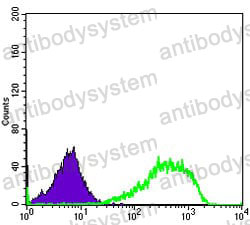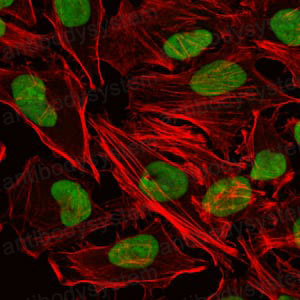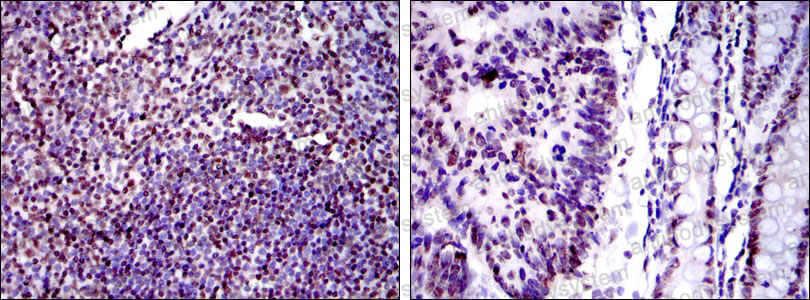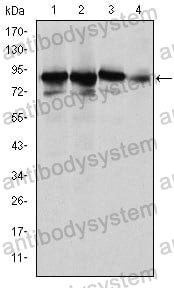Catalog No.
RHC96101
Species reactivity
Human, Mouse
Host species
Mouse
Isotype
IgG1
Clonality
Monoclonal
Tested applications
ELISA: 1:10000, FCM: 1:200-1:400, IF: 1:200-1:1000, IHC: 1:200-1:1000, WB: 1:500-1:2000
Target
Lupus Ku autoantigen protein p86, XRCC5, Thyroid-lupus autoantigen, Ku86, ATP-dependent DNA helicase 2 subunit 2, CTC85, G22P2, DNA repair protein XRCC5, 86 kDa subunit of Ku antigen, TLAA, Nuclear factor IV, CTC box-binding factor 85 kDa subunit, ATP-dependent DNA helicase II 80 kDa subunit, CTCBF, Ku80, X-ray repair complementing defective repair in Chinese hamster cells 5 (double-strand-break rejoining), X-ray repair cross-complementing protein 5
Concentration
1 mg/ml
Endotoxin level
Please contact with the lab for this information.
Purity
>95% as determined by SDS-PAGE.
Purification
Protein A/G purified from cell culture supernatant.
Accession
P13010
Applications
ELISA, FCM, IF, IHC, WB
Form
Liquid
Storage buffer
0.01M PBS, pH 7.4, 0.05% Sodium Azide.
Stability and Storage
Use a manual defrost freezer and avoid repeated freeze-thaw cycles. Store at 4°C short term (1-2 weeks). Store at -20°C 12 months. Store at -80°C long term.
Clone ID
R3D09
The DNA repair factor ku80 binds and activates the adhesion receptor ELTD1/ADGRL4., PMID:40245572
Nuclear expression of Ku70/80 is associated with CHEK2 germline mutations in breast cancer., PMID:37728466
Selenium Nanoparticles Can Influence the Immune Response Due to Interactions with Antibodies and Modulation of the Physiological State of Granulocytes., PMID:36559266
Characterization of Double-Strand Break Repair Protein Ku80 Location Within the Murine Retina., PMID:35737378
Chest pain in a mid-aged woman, not simply myopericarditis: a case report of anti-Ku positive polymyositis., PMID:34362296
Structural basis of long-range to short-range synaptic transition in NHEJ., PMID:33854234
Basic fibroblast growth factor promotes doxorubicin resistance in chondrosarcoma cells by affecting XRCC5 expression., PMID:31916307
Ku80 gene knockdown by the CRISPR/Cas9 technique affects the biological functions of human thyroid carcinoma cells., PMID:31578590
Blood Donation During Pregnancy Due to Anti-Ku Hemolytic Disease of the Fetus and Newborn., PMID:31089725
Comparative proteomic study reveals the enhanced immune response with the blockade of interleukin 10 with anti-IL-10 and anti-IL-10 receptor antibodies in human U937 cells., PMID:30897137
Camptocormia with trigeminal involvement revealing myositis with anti-Ku antibodies., PMID:29653283
Rad52 competes with Ku70/Ku86 for binding to S-region DSB ends to modulate antibody class-switch DNA recombination., PMID:28176781
Calcium influx-mediated translocation of m-calpain induces Ku80 cleavage and enhances the Ku80-related DNA repair pathway., PMID:27121057
The proteomic investigation reveals interaction of mdig protein with the machinery of DNA double-strand break repair., PMID:26293673
Influence of allelic Variations of hypoxia-related and DNA repair genes on patient outcome and toxicity in head and neck cancer treated with radiotherapy plus cetuximab., PMID:26245169
Genomic analysis of xCT-mediated regulatory network: Identification of novel targets against AIDS-associated lymphoma., PMID:25860939
Association Between Functional Polymorphisms of DNA Double-Strand Breaks in Repair Genes XRCC5, XRCC6 and XRCC7 with the Risk of Systemic Lupus Erythematosus in South East Iran., PMID:25756210
SMCHD1 accumulates at DNA damage sites and facilitates the repair of DNA double-strand breaks., PMID:24790221
Expression of Ku86 and presence of Ku86 antibody as biomarkers of hepatitis B virus related hepatocellular carcinoma., PMID:24271118
A subset of systemic sclerosis but not of systemic lupus erythematosus is defined by isolated anti-Ku autoantibodies., PMID:23910615
Characterization of estrogen response element binding proteins as biomarkers of breast cancer behavior., PMID:23868020
DNA ends alter the molecular composition and localization of Ku multicomponent complexes., PMID:22535209
DNA repair biomarker profiling of head and neck cancer: Ku80 expression predicts locoregional failure and death following radiotherapy., PMID:21349997
Ku86 is important for TrkA overexpression-induced breast cancer cell invasion., PMID:21137076
Use of phage display to isolate specific human monoclonal antibody fragments against a potential target for multiple myeloma., PMID:19652854
Ku86 represses lethal telomere deletion events in human somatic cells., PMID:19581589
Human DNA ligases I and III, but not ligase IV, are required for microhomology-mediated end joining of DNA double-strand breaks., PMID:18440984
Cell-surface MMP-9 regulates the invasive capacity of leukemia blast cells with monocytic features., PMID:18414048
Possible involvement of oxidative stress in fenofibrate-induced hepatocarcinogenesis in rats., PMID:18253720
Variation in DNA repair genes XRCC3, XRCC4, XRCC5 and susceptibility to myeloma., PMID:17901044
Wnt signaling controls radiosensitivity via cyclooxygenase-2-mediated Ku expression in head and neck cancer., PMID:17764107
Arsenite-induced alterations in Ku70-deficient cells: a model to study genotoxic effects., PMID:17479409
A novel human AP endonuclease with conserved zinc-finger-like motifs involved in DNA strand break responses., PMID:17396150
Electrophoretic mobility shift assays to study protein binding to damaged DNA., PMID:16673891
Association between autoantibodies to the Ku protein and DPB1*., PMID:15693000
Association of DNA-dependent protein kinase with hypoxia inducible factor-1 and its implication in resistance to anticancer drugs in hypoxic tumor cells., PMID:15272235
The Membrane-associated form of the DNA repair protein Ku is involved in cell adhesion to fibronectin., PMID:15019772
Biochemical evidence for Ku-independent backup pathways of NHEJ., PMID:12954774
DNA damage modulates nucleolar interaction of the Werner protein with the AAA ATPase p97/VCP., PMID:12937274
Competition between the Rad50 complex and the Ku heterodimer reveals a role for Exo1 in processing double-strand breaks but not telomeres., PMID:12861005
Increased error-prone NHEJ activity in myeloid leukemias is associated with DNA damage at sites that recruit key nonhomologous end-joining proteins., PMID:12702565
Selective inhibition of class switching to IgG and IgE by recruitment of the HoxC4 and Oct-1 homeodomain proteins and Ku70/Ku86 to newly identified ATTT cis-elements., PMID:12672812
Novel localization of the DNA-PK complex in lipid rafts: a putative role in the signal transduction pathway of the ionizing radiation response., PMID:12672807
The barrier-to-autointegration factor is a component of functional human immunodeficiency virus type 1 preintegration complexes., PMID:12663813
Interaction between Ku80 protein and a widely used antibody to adenomatous polyposis coli., PMID:12610503
Anti-Ku antibody-positive scleroderma-dermatomyositis overlap syndrome developing Graves' disease and immune thrombocytopenic purpura., PMID:12521216
Clinical significance of anti-Ku autoantibodies--a serologic marker of overlap syndrome?, PMID:12521194
Analysis of the DNA replication competence of the xrs-5 mutant cells defective in Ku86., PMID:12456721
Ku antigen, an origin-specific binding protein that associates with replication proteins, is required for mammalian DNA replication., PMID:12393188
Human Ku70/80 associates physically with telomerase through interaction with hTERT., PMID:12377759




